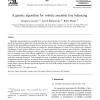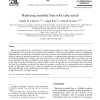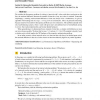11 search results - page 2 / 3 » A classification of assembly line balancing problems |
EOR
2006
13 years 5 months ago
2006
Flexibility and automation in assembly lines can be achieved by the use of robots. The robotic assembly line balancing (RALB) problem is defined for robotic assembly line, where d...
EOR
2006
13 years 5 months ago
2006
Balancing assembly lines is a crucial task for manufacturing companies in order to improve productivity and minimize production costs. Despite some progress in exact methods to so...
ARC
2010
Springer
13 years 5 months ago
2010
Springer
: When a logistics system is "self-organizing" it can function without significant intervention by managers, engineers, or software control. The social insects, such as a...
CORR
2010
Springer
13 years 2 months ago
2010
Springer
We consider the discrepancy problem of coloring n intervals with k colors such that at each point on the line, the maximal difference between the number of intervals of any two co...
INFOCOM
2005
IEEE
13 years 10 months ago
2005
IEEE
Packet Classification (PC) has been a critical data path function for many emerging networking applications. An interesting approach is the use of TCAM to achieve deterministic, hi...




